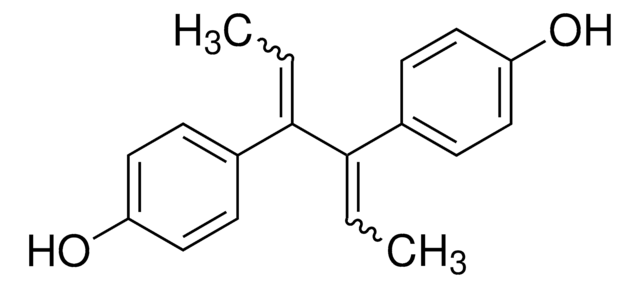D4628
Diethylstilbestrol
≥99% (HPLC)
Synonym(s):
(E)-3,4-Bis(4-hydroxyphenyl)-3-hexene, DES, Stilbestrol
About This Item
Recommended Products
Assay
≥99% (HPLC)
form
powder
SMILES string
CC\C(c1ccc(O)cc1)=C(\CC)c2ccc(O)cc2
InChI
1S/C18H20O2/c1-3-17(13-5-9-15(19)10-6-13)18(4-2)14-7-11-16(20)12-8-14/h5-12,19-20H,3-4H2,1-2H3/b18-17+
InChI key
RGLYKWWBQGJZGM-ISLYRVAYSA-N
Gene Information
human ... ESR1(2099) , ESR2(2100) , ESRRG(2104)
mouse ... Esr1(13982)
rat ... Ar(24208) , Esr1(24890)
Looking for similar products? Visit Product Comparison Guide
Related Categories
Application
- to evaluate the estrogenic activity of diethylstilbestrol by quantitating the expression levels of endogenous estrogen-regulated marker genes
- to evaluate the estrogenic, androgenic and toxicity responses in bioluminescent yeast bioreporter assay (BLYES)
- to detect its effect on the proliferation and tyrosinase activity of melanocytes
Biochem/physiol Actions
Signal Word
Danger
Hazard Statements
Precautionary Statements
Hazard Classifications
Aquatic Acute 1 - Aquatic Chronic 1 - Carc. 1B - Eye Irrit. 2 - Repr. 1B - Skin Irrit. 2 - STOT SE 3
Target Organs
Respiratory system
Storage Class Code
6.1C - Combustible acute toxic Cat.3 / toxic compounds or compounds which causing chronic effects
WGK
WGK 3
Personal Protective Equipment
Certificates of Analysis (COA)
Search for Certificates of Analysis (COA) by entering the products Lot/Batch Number. Lot and Batch Numbers can be found on a product’s label following the words ‘Lot’ or ‘Batch’.
Already Own This Product?
Find documentation for the products that you have recently purchased in the Document Library.
Customers Also Viewed
Articles
Cancer research has revealed that the classical model of carcinogenesis, a three step process consisting of initiation, promotion, and progression, is not complete.
Our team of scientists has experience in all areas of research including Life Science, Material Science, Chemical Synthesis, Chromatography, Analytical and many others.
Contact Technical Service











